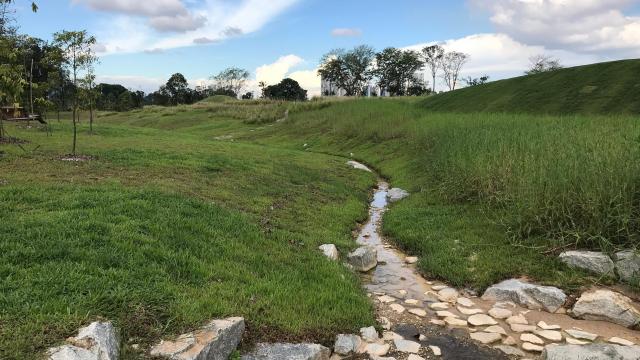Given how much destruction droughts can cause, it can be easy to forget the fact that having too much water is also a problem. And not only when a massive, area-wide flood drowns a town — just one heavy rainstorm can do a surprising amount of damage to a garden.
While there are some things you can’t fix or control — like the weather and, for the most part, the topography in your area — there are a few management techniques that can help keep your garden from flooding after a downpour. In a recent article for the Kansas City Star, Dennis Patton, a horticulture agent with Kansas State University Research and Extension, shares two of these strategies: a bioswale and a rain garden.
Construct a bioswale
If you haven’t come across the term before, a bioswale is a channel that collects rainwater runoff after a storm. Here’s how Patton describes bioswales and how they can help your garden:
As the water moves through the channel, the mixture of native plants slows the movement and increases infiltration to remove pollutants. Unlike a rain garden, the filtered water leaves the bioswale instead of collecting it. Bioswales can be used in combination with a rain garden. The swale moves the water to the rain garden to thoroughly soak into the soil…A properly constructed swale will channel the rainwater, slow the movement, and provide environmental benefits. The goal is not to trap additional water on the property with a rain garden.
This post from the Pinoleville Pomo Nation Environmental Department walks you through the steps of creating your own bioswale.
Plant a rain garden
Back in March, we published a post discussing the purposes served by a rain garden, and how to make your own. This is also a strategy Patton recommends to help keep your main garden (and property in general) free from flooding. Here, he makes his case for rain gardens:
Rain gardens are characterised by a depression in the soil, collecting runoff from rooftops and driveways. They can catch up to the first inch of rain, allowing it to soak into the ground.
When properly constructed, rain gardens should drain, not have standing water within 24 to 48 hours of the rain event. Soaking into the soil quickly reduces issues with mosquitoes.
But you can’t just randomly pick a spot in your yard to build a rain garden and expect to it be effective. It should be located 10 to 15 feet away from your home in a spot with good drainage, so as not to overburden an area that’s already prone to flooding.
According to Patton, a rain garden should include, “a mixture of native grasses and perennial plants with deep, fibrous roots to break up the soil and aid in water movement.” And that’s not all: This mix of plants can make a nice habitat for pollinators and birds.

Leave a Reply
You must be logged in to post a comment.